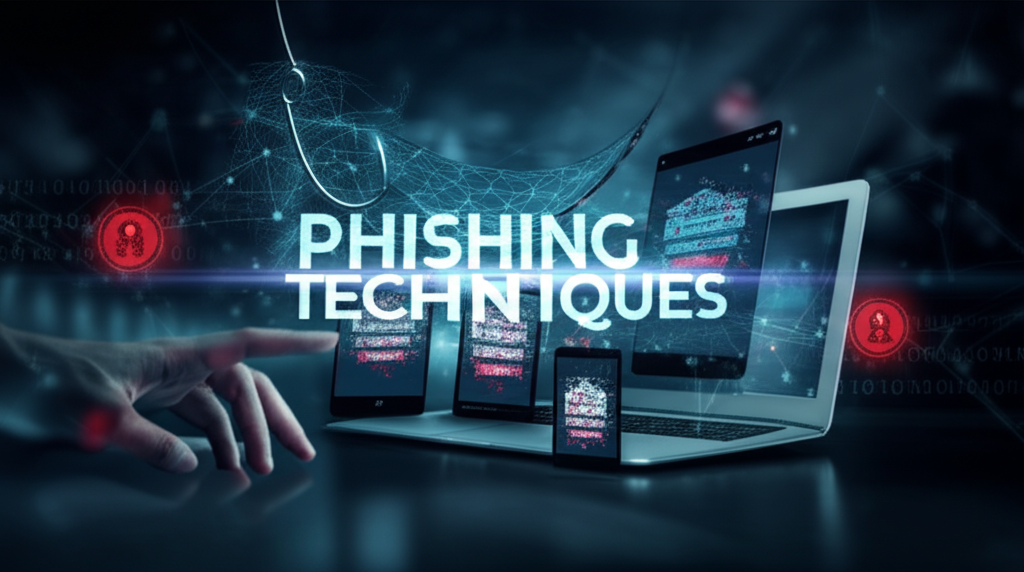8 Phishing Techniques: A Comprehensive Guide to Staying Safe Online
In the digital age, cybersecurity threats are ever-present, and among the most insidious is phishing. Phishing attacks trick unsuspecting individuals into revealing sensitive information, such as passwords, credit card numbers, or personal data. These attacks are not only becoming more sophisticated but also more diverse, making it crucial for everyone to understand the various techniques employed by cybercriminals.
This article will delve into eight common phishing techniques, equipping you with the knowledge needed to recognize and defend against these pervasive threats. From the familiar fake email to more advanced social engineering tactics, understanding these methods is your first line of defense.
Understanding the Threat: What is Phishing?
Phishing is a type of social engineering attack where an attacker, disguised as a trustworthy entity, attempts to acquire sensitive information from victims. This is typically done through deceptive emails, text messages, phone calls, or websites that mimic legitimate sources. The goal is always the same: to manipulate individuals into taking an action that compromises their security, often leading to financial loss, identity theft, or data breaches.
8 Common Phishing Techniques You Must Know
Phishing isn’t a single attack method; it’s an umbrella term for a variety of deceptive practices. Here are eight of the most prevalent techniques:
1. Email Phishing (Traditional Phishing)
This is the classic form of phishing, where attackers send a fraudulent email designed to look like it came from a legitimate source, such as a bank, a popular online service, or a government agency. These emails often contain urgent language, threats, or enticing offers, compelling recipients to click on malicious links or download infected attachments. The links typically lead to fake websites that harvest credentials.
2. Spear Phishing
More targeted than traditional email phishing, spear phishing attacks are directed at specific individuals or organizations. Attackers conduct research to gather personal information about their targets, such as their job title, interests, or relationships. This information is then used to craft highly personalized and believable emails, increasing the likelihood that the victim will fall for the scam. For example, an email might appear to be from a colleague or a superior, requesting confidential information.
3. Whaling
Whaling is a highly sophisticated form of spear phishing that specifically targets high-profile individuals, typically senior executives (e.g., CEOs, CFOs) or high-net-worth individuals. The goal is usually to authorize large wire transfers or to obtain sensitive company data. These attacks are meticulously crafted, often impersonating legal counsel, board members, or other high-level contacts.
4. Smishing (SMS Phishing)
Smishing involves using text messages (SMS) to trick victims. Attackers send messages that appear to be from banks, retailers, shipping companies, or government bodies, often containing a malicious link or a phone number to call. Common examples include fake delivery notifications, urgent account alerts, or offers for free gifts that require personal information.
5. Vishing (Voice Phishing)
Vishing uses voice communication—phone calls—to defraud victims. Attackers impersonate legitimate entities like bank representatives, tech support, government officials (e.g., IRS), or law enforcement. They often use scare tactics, urgency, or promises of help to convince victims to reveal sensitive information, transfer money, or grant remote access to their computers.
6. Pharming
Pharming is a more advanced technique that redirects users from a legitimate website to a fraudulent one, even if they type the correct web address. This is typically achieved through DNS poisoning, where the attacker compromises a DNS server or a user’s local host file. The user believes they are interacting with a trusted site, but their data is being captured by the attacker.
7. Clone Phishing
In clone phishing, attackers replicate a legitimate, previously delivered email (e.g., an invoice, a newsletter, a delivery notification) and send it again, but with malicious links or attachments replacing the original legitimate ones. They might claim there was an issue with the previous delivery or that a file needs to be updated, making the email seem even more credible because the recipient has seen a similar communication before.
8. Evil Twin Phishing
Evil Twin phishing involves setting up a fraudulent Wi-Fi access point that mimics a legitimate one (e.g., “Free Airport Wi-Fi”). When unsuspecting users connect to this “evil twin” hotspot, the attacker can intercept all their internet traffic, including login credentials, banking details, and other sensitive information transmitted over the unencrypted network.
Protecting Yourself from Phishing Attacks
Awareness is your strongest defense against phishing. Here are some essential tips:
- Be Skeptical: Always question unsolicited emails, messages, or calls, especially if they ask for personal information.
- Verify the Sender: Check the sender’s email address carefully for discrepancies. Don’t just rely on the display name.
- Hover Before Clicking: Before clicking any link, hover your mouse over it to see the actual URL. If it looks suspicious, don’t click.
- Use Strong, Unique Passwords and MFA: Employ strong, unique passwords for all your accounts and enable multi-factor authentication (MFA) whenever possible.
- Update Software: Keep your operating system, web browser, and security software up to date.
- Report Suspicious Activity: If you receive a phishing attempt, report it to your IT department (if at work), email provider, or relevant authorities.
- Check for HTTPS: Ensure websites are secure (look for ‘https://’ and a padlock icon in the address bar) before entering sensitive information.
Conclusion
Phishing techniques are constantly evolving, but the core principle remains the same: exploiting human trust and curiosity. By understanding the common methods cybercriminals use, from straightforward email scams to highly targeted spear phishing and advanced pharming, you can significantly reduce your vulnerability. Stay informed, stay vigilant, and always think before you click.







